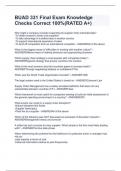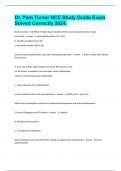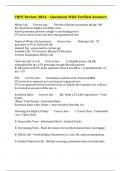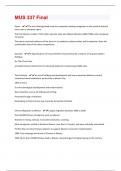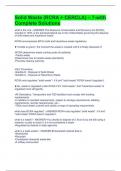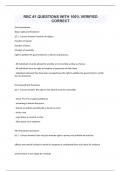Week 1
Sensory perception/ consumer preference=Bringing outside information inside the human system
Cross-modal correspondences=i.e., certain colours fit w/ certain odours based on biological
mechanism, learnt association or emotions.
Sensory marketing
• Marketing that engages the consumers’ senses and affects their perception, judgement, and
behaviour.
• 5 senses= Haptics (touch), olfaction (smell), audition (sound), gustation (taste), vision (sight)
• Often subconscious but predictable effects
Grounded cognition;
• Cognition that is affected by an unmoving physical condition that smn is in or by movement in
parts of the body.
• Bodily states result in behaviours (recognizing the emotion is not needed, effects remain even
for people who are aware of the purpose of the study, amplifies and initiates ongoing feelings
(i.e., pen in the mouth)
• Mental imagery may be enough to drive cognition
• Sensory perception can also affect perceived emotions (grounded emotion)
Sensory effect; participants list cleaning activities in the scent condition rather than in control.
• Scent can have non-conscious effects on cognition (thinking) and behaviour (doing). Through
associations w/ scent the cleaning concept came into consciousness (accessibility).
Sonic Branding=the expression of your brand through sound
Consumers value sensory experience by enjoying the outcome vs enjoying the process.
Kano Model= prioritizing features on a product based on the degree to which they are likely to satisfy
customers.
1
,Processes through which sensory input affects responses;
Liking
Schema (people pay attention to the things that fit with their current schemas)
Purpose/ meaning
Environment
Influential factors (moderators);
• Context/ situation
• Individual traits (highly sensitive people, need for touch (NFT) provides confidence but can
also promote disgust if many people appear to have touched the same thing)
Consumers used to buy what was offered to them. Now they have a choice (saturation) according to
price, pleasure, convenience, healthiness, sustainability (their view of quality).
Reasons for new product development (never ending process)
▪ Changing consumer needs ▪ Competition ▪ New technologies ▪ To address societal issues ▪ To comply
with new legislation
2
, Step by step food design: idea generation
The goal is to be different (unique not better), can they get it quickly?
Target is important- people want to feel unique (product with personality), a product for everyone is a
product for no one.
Three specific rules; ● Consumers do not perceive your products as a separate category ● They should
“beat the best” or at least be as good as the standard one with a specific plus ● They must be excellent
in one specific need of the target.
Step by step food design: general technological strategy
▪ Modification/selection of starting material
▪ Modification/adaptation of the processing
▪ Formulation solutions
Step by step food design: specific strategies
▪ Me-too (same product, different brand)
▪ Line extensions
▪ Repositioned existing products (new story behind it, what you decide to focus on and promote)
▪ New forms of existing products (existing products that have been changed into another form
(e.g., concentrated, spreadable, dried or frozen), canned soups → dried soups
▪ Reformulation of existing products (existing products that get a new formula; the product
characteristics hardly change. i.e., reduce ingredient costs), (process of altering the processing
or composition of a product, to improve its nutritional profile or to reduce its content of
ingredients or nutrients of concern)
▪ New packaging of existing products
▪ Use of innovative ingredients (More rigorous changes. The changes must have and add value
to the consumer (solve a problem). Ex: incorporation of a hunger-suppressing ingredient)
▪ Blue sky innovation (a form of creative brainstorming. If there were absolutely no limits, no
judgments, and no consequences, where could your imagination take you? The sky's the limit)
Societal and food trends
▪ Reduction/Elimination (“free from”-for health/ nutritional, ethical reasons)
▪ Organic/Naturalness/Less processing- in consumers’ mind these overlap. Are related to health,
sustainability, and heritage • Organic has clearly defined rules • Naturality depends on may
factors. Difficult to define. Used a lot because of it. •Health is related to the overall
diet/lifestyle. • Minimal processing is even more ambiguous. The NOVA classification is now
ramping up (groups all foods according to the nature, extent, and purposes of the industrial
processes they undergo)
▪ Vegan/Vegetarian/Sustainable
▪ New taste/adventure/exotic
▪ Convenience/on the go
▪ Enrichment/Superfoods
▪ Intestinal Health/Immunity (Covid)
Trends→ lactose free, Snackification, online retailing, meal kits, needs of consumer mf!
3
Sensory perception/ consumer preference=Bringing outside information inside the human system
Cross-modal correspondences=i.e., certain colours fit w/ certain odours based on biological
mechanism, learnt association or emotions.
Sensory marketing
• Marketing that engages the consumers’ senses and affects their perception, judgement, and
behaviour.
• 5 senses= Haptics (touch), olfaction (smell), audition (sound), gustation (taste), vision (sight)
• Often subconscious but predictable effects
Grounded cognition;
• Cognition that is affected by an unmoving physical condition that smn is in or by movement in
parts of the body.
• Bodily states result in behaviours (recognizing the emotion is not needed, effects remain even
for people who are aware of the purpose of the study, amplifies and initiates ongoing feelings
(i.e., pen in the mouth)
• Mental imagery may be enough to drive cognition
• Sensory perception can also affect perceived emotions (grounded emotion)
Sensory effect; participants list cleaning activities in the scent condition rather than in control.
• Scent can have non-conscious effects on cognition (thinking) and behaviour (doing). Through
associations w/ scent the cleaning concept came into consciousness (accessibility).
Sonic Branding=the expression of your brand through sound
Consumers value sensory experience by enjoying the outcome vs enjoying the process.
Kano Model= prioritizing features on a product based on the degree to which they are likely to satisfy
customers.
1
,Processes through which sensory input affects responses;
Liking
Schema (people pay attention to the things that fit with their current schemas)
Purpose/ meaning
Environment
Influential factors (moderators);
• Context/ situation
• Individual traits (highly sensitive people, need for touch (NFT) provides confidence but can
also promote disgust if many people appear to have touched the same thing)
Consumers used to buy what was offered to them. Now they have a choice (saturation) according to
price, pleasure, convenience, healthiness, sustainability (their view of quality).
Reasons for new product development (never ending process)
▪ Changing consumer needs ▪ Competition ▪ New technologies ▪ To address societal issues ▪ To comply
with new legislation
2
, Step by step food design: idea generation
The goal is to be different (unique not better), can they get it quickly?
Target is important- people want to feel unique (product with personality), a product for everyone is a
product for no one.
Three specific rules; ● Consumers do not perceive your products as a separate category ● They should
“beat the best” or at least be as good as the standard one with a specific plus ● They must be excellent
in one specific need of the target.
Step by step food design: general technological strategy
▪ Modification/selection of starting material
▪ Modification/adaptation of the processing
▪ Formulation solutions
Step by step food design: specific strategies
▪ Me-too (same product, different brand)
▪ Line extensions
▪ Repositioned existing products (new story behind it, what you decide to focus on and promote)
▪ New forms of existing products (existing products that have been changed into another form
(e.g., concentrated, spreadable, dried or frozen), canned soups → dried soups
▪ Reformulation of existing products (existing products that get a new formula; the product
characteristics hardly change. i.e., reduce ingredient costs), (process of altering the processing
or composition of a product, to improve its nutritional profile or to reduce its content of
ingredients or nutrients of concern)
▪ New packaging of existing products
▪ Use of innovative ingredients (More rigorous changes. The changes must have and add value
to the consumer (solve a problem). Ex: incorporation of a hunger-suppressing ingredient)
▪ Blue sky innovation (a form of creative brainstorming. If there were absolutely no limits, no
judgments, and no consequences, where could your imagination take you? The sky's the limit)
Societal and food trends
▪ Reduction/Elimination (“free from”-for health/ nutritional, ethical reasons)
▪ Organic/Naturalness/Less processing- in consumers’ mind these overlap. Are related to health,
sustainability, and heritage • Organic has clearly defined rules • Naturality depends on may
factors. Difficult to define. Used a lot because of it. •Health is related to the overall
diet/lifestyle. • Minimal processing is even more ambiguous. The NOVA classification is now
ramping up (groups all foods according to the nature, extent, and purposes of the industrial
processes they undergo)
▪ Vegan/Vegetarian/Sustainable
▪ New taste/adventure/exotic
▪ Convenience/on the go
▪ Enrichment/Superfoods
▪ Intestinal Health/Immunity (Covid)
Trends→ lactose free, Snackification, online retailing, meal kits, needs of consumer mf!
3


